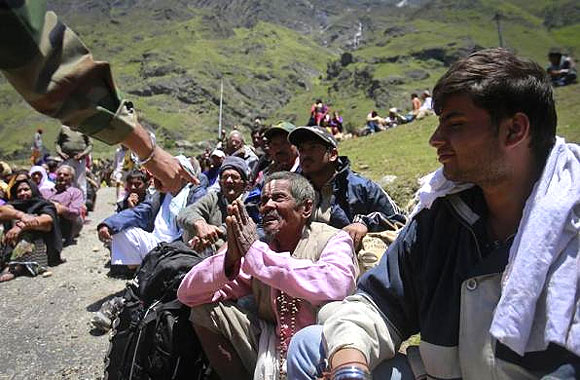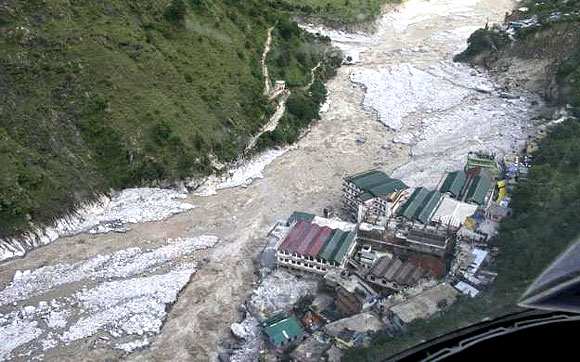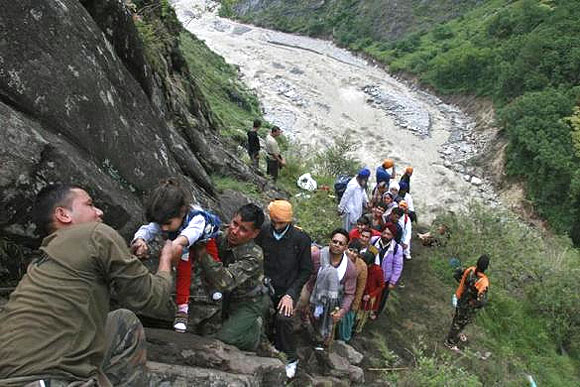Photographs: Danish Siddiqui/Reuters Anand Sankar in Dehradun
The suspension of the Char Dham Yatra this year and its cancellation the next will be a huge blow to Uttarakhand’s unorganised sector
The earth movers on the banks of the Assiganga, a medium-sized stream flowing into the Bhagirathi (the major tributary of the Ganga) never rested after monsoon 2012.
The scenic Assiganga valley, popular with nature lovers, became scarred forever on August 3, 2012.
A freak cloudburst (sudden intense local precipitation usually lasting less than an hour) swelled the Assiganga a thousand-fold, obliterated the village of Sangamchatti, and came within inches of tearing into the large town of Uttarkashi, one of the hubs of the Chota Char-Dham Yatra (Yamunotri-Gangotri-Kedarnath-Badrinath).
The valley, when visited in early summer 2013, resembled a moonscape, with vehicles having to crawl through the devastation to reach the three buildings still standing at Sangamchatti.
Now, nothing remains of the meagre recovery by the earth movers, and it looks like the event was just the teaser before the big opening.
Click on NEXT for more...
After floods, mainstay of religious tourism in danger of drowning
Image: Flood waters flow next to a residential complex.Photographs: Reuters
While 2012 saw an isolated cloudburst, monsoon 2013 marked its early entry into Uttarakhand around June 14-15 with a devastating spell of very heavy rainfall in less than 48 hours. Official data on how much rained in the higher altitudes are not available; however, the state capital recorded 340 mm in a 24 hours.
The region devastated is the entire Ganga valley, which comprises two major tributaries, Alaknanda and Bagirathi. As with a disaster, this one, too, has been predictably covered by news channels based in New Delhi.
While there has been clamour for speedy rescue and blame game, the coverage has sorely missed the point when it comes to ground reality.
The principal failing that has led to this tragedy which is still unfolding is the wilful ignorance of flood-plain zoning in river basins across the country.
As recently as 2011, a planning commission report lamented the fact that while thousands of crores of rupees are poured into planned flood management programmes, there is no enforceable policy on flood-plain zoning, which can save the exchequer a lot of money, and save life and property.
The problem has been exacerbated by the fact that flood-plain zoning is a state subject; Uttarakhand is perhaps the shining example of this failure.
Click on NEXT for more...
After floods, mainstay of religious tourism in danger of drowning
Image: The Kedarnath Temple (C) is pictured amid damaged surroundings.Photographs: Reuters
The Chhota Char Dham Yatra is the biggest annual event in Uttarakhand’s calendar.
In its of roughly four-month duration, there is a seasonal influx of people to the higher reaches, comprising pilgrims (about 6-7,00,000, in 2012) and a commensurate numbers of labourers to offer them services.
The population in the region thus swells to several times the local population. In the last two decades, the entire Ganga valley has seen rampant unregulated constructions, by those wanting to profit from this seasonal influx.
The scarcity of flat terrain has meant that flood plains along the rivers have been mercilessly encroached upon.
Fetishes have gone to the extent of building ‘homes’ near these shrines - multi-storey apartment blocks for seasonal pilgrims in the mountains.
While the huge Shiva statue drowning at Rishikesh has become the iconic picture of this disaster, it is also symbolic of rampant abuse of a lack of regulation.
It took the 2004 tsunami to wake us up to the need to enforce a Coastal Regulatory Zone (CRZ), but what about the floodplains of our rivers?
Click on NEXT for more...
After floods, mainstay of religious tourism in danger of drowning
Image: Soldiers rescue stranded people.Photographs: Reuters
While the terrain is harsh, rescue efforts have been made complex due to the fact that the seasonal visitors are not mountain people.
These visitors do not appreciate the hardship of life in the mountains.
Building of motorable roads almost to the gates of holy shrines has meant even the old and the infirm can visit these place.
These are the very people who are at highest risk when a disaster strikes and demand most of the rescue efforts. But the biggest failure is the lack of an officially sanctioned scientific study to assess the carrying capacity of these areas.
The number of seasonal visitors is not regulated according to the carrying capacity of the places. The problem is made worse due to the trend of people wanting to do a yatra every year, or do multiple yatras in a year; when according to tradition, it is said one need to do this yatra only once in a lifetime.
In essence, the 2012 Assiganga cloudburst should have served as a warning of things to come. A disaster waiting to happen.
Click on NEXT for more...
After floods, mainstay of religious tourism in danger of drowning
Image: People carry oil lamps as they pray for the flood victims.Photographs: Amit Dave/Reuters
It’s a failure to not foresee such an eventuality. The history of independent India is filled with instances where pilgrimage sites get disaster management plans only after being hit by a major disaster. What is needed now is patience, for the rescue efforts to end.
While it is easy to look up at the sky and see helicopters as harbinger of hope, they are simply inadequate for the mammoth task at hand.
Real help can only arrive when the roads are repaired. Helicopters operate in the mountains with severe restrictions on payload.
At 10,000 feet, a helicopter’s payload can get reduced by half. Moreover, mountain weather is the worst to fly in.
We are actually putting the lives of a lot of crew in harm’s way by asking them to fly in marginal conditions. Helicopters can at best get medical professionals to the scene and fly out the most critically injured. The rest have to wait.
Click on NEXT for more...
After floods, mainstay of religious tourism in danger of drowning
Image: A submerged statue of Lord Shiva stands amid the flooded waters of river Ganges at Rishikesh.Photographs: Reuters
From the evidence gathered from the destruction, it is highly unlikely that the yatra will resume even in 2014.
The suspension this year and cancellation next will be a huge blow to the state’s economy. Since it is an unorganised sector, it is hard to quantify the loss in numbers, but the impact will be felt from the grain wholesaler in Dehradun to the mule herder in the higher reaches.
The priority for the government now is to provide the affected with means of sustenance.
The post-mortem will now follow, and one can only hope lessons are learnt, and humans learn to give the rivers the right of way.
The author is a journalist and travel entrepreneur based in Dehradun








article